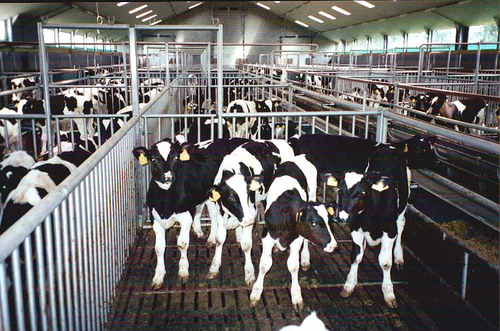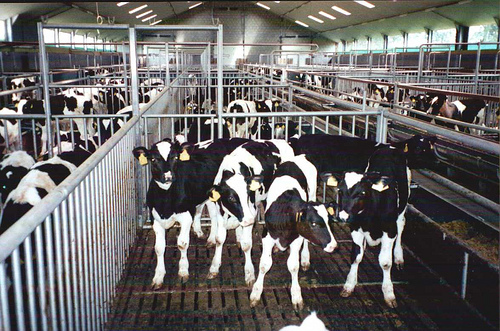 Four companies currently control 90 percent of all beef processing in the U.S. Photo: Compassion in World FarmingOne of the least-discussed but most promising attempts at food system reform was dealt a serious blow the other day. The USDA itself eviscerated its proposed reform to a set of rules which would have given a government division with a wonky name — the Grain Inspection, Packers and Stockyard Administration (GIPSA) — authority to crack down on the way large corporate meatpackers wield power over small and mid-sized ranchers.
Four companies currently control 90 percent of all beef processing in the U.S. Photo: Compassion in World FarmingOne of the least-discussed but most promising attempts at food system reform was dealt a serious blow the other day. The USDA itself eviscerated its proposed reform to a set of rules which would have given a government division with a wonky name — the Grain Inspection, Packers and Stockyard Administration (GIPSA) — authority to crack down on the way large corporate meatpackers wield power over small and mid-sized ranchers.
To say this was a lost opportunity is a vast understatement. After all, the top four companies control 90 percent of all beef processing. In the case of pork, four companies control 70 percent of the processing, while for poultry it’s nearly 60 percent. When you get that kind of market power,* abuse becomes rampant. Indeed, ranchers all around the country now agree that it’s impossible for them to get a fair price for livestock.
And it’s not just the ranchers who hold that opinion. As hard as it is to believe, back in 2008, a group of farm-state senators inserted language into that year’s Farm Bill that forced the USDA to address the unfairness in livestock markets.
The existing livestock laws date back to 1921 — when the government first identified the need to level the playing field for smaller ranchers — but since then it has been observed almost entirely in the breach (i.e. not so much at all). But in 2009, USDA Chief Tom Vilsack called in reform-minded lawyer Dudley Butler to head the division in charge of livestock markets. Butler declared that he was coming to Washington “to enforce the Packers and Stockyards Act.” Not fix, mind you, enforce. And some would say for the first time.
All of this effort is to halt what has been called the “chickenization” of the rest of the livestock industry. As reporter Stephanie Ogburn explained in an in-depth report for the High Country News, that we ran here at Grist, the poultry industry is run in such a way that allows single companies to own every step of the process (also known as “vertical integration”), while farmers get locked into lose-lose contracts. As Ogburn wrote:
90 percent of all poultry in the U.S. is now raised by growers who don’t own the birds or negotiate basic terms like price per pound …
Many chicken farmers these days are forced, contractually, to invest hundreds of thousands of dollars in chicken houses that meet ever-changing packer specifications.
If anything goes wrong, as it often does, it’s the farmer who’s left holding the bag chickens with no recourse from the meatpackers. If things remain as they are, that kind of indentured servitude represents the future for most beef and pork growers. All the power will remain with a handful of massive corporate behemoths, and ranchers will be glorified hired help taking on all the risk and getting little or no reward.
Believe it or not, the USDA’s Vilsack and Butler came through last year with strong new proposed rules to protect smaller producers that would have changed all that. The draft rule garnered support from many quarters — including the typically Big Ag-friendly American Farm Bureau — and prompted the moderate ag lobbying group the National Farmers Union to refer to it approvingly as “the Ranchers Bill of Rights.”
Of course, the rule soon came under withering assault from the meatpacking industry, which commissioned a study designed to prove that the new rule would cost a ludicrous $14 billion and 104,000 jobs. Meanwhile, no mention was made of how many jobs might be saved by the rule — cattle ranching alone has shed 650,000 jobs over the last 30 years, while the number of hog farms dropped by 170,000 between 1992 and 2004, which can only have cost jobs.
The meatpackers also convinced Congress to hold a series of hearings packed with pro-Big Ag witnesses while House Republicans attempted to defund USDA work on the rule entirely (just recently foiled by the Senate). In short, the industry was hell-bent to kill this reform. That alone should tell you how important it was.
Unfortunately, as the debate ground on, so did the Great Recession. Meanwhile, the disastrous 2010 midterm elections made any kind of reform that much harder. And, with the 2012 election on the horizon, the Obama administration became obsessed with placating a business community that is equally obsessed with his downfall.
As a part of that strategy, when Obama’s Chief of Staff Rahm Emmanuel resigned to run for Mayor of Chicago, another Chicagoan and a JP Morgan executive(!), former Commerce Secretary Bill Daley, was brought in as his replacement to help soothe ruffled corporate feathers.
And why would this matter? Because the White House Office for Management and Budget (OMB) reviews and approves all new federal regulations. Since Daley, as Chief of Staff, effectively runs the White House day-to-day, his mantra of corporate conciliation has seeped into every corner, including the OMB.
This reality effectively gives Daley huge influence over all regulatory reform. In other words, rules that have been carefully constructed by federal agencies, have gone through extensive public comment periods and even more revision, can be altered, that is to say weakened, by OMB economists on the basis of “economic impact.” This creates the opportunity for vested interests to apply heavy, behind-the-scenes lobbying pressure.
A form of this kind of pressure played out earlier this year when the White House intervened in USDA’s attempts to restrict the planting of genetically modified alfalfa. Vilsack himself was personally humiliated in that fight, as his very public position to restrict GE alfalfa was steamrolled by a White House concerned with the corporate reactions. And he clearly got the message for future reform attempts. In the case of the livestock rule, rather than facing the White House steamroller again, the USDA did the dirty work itself and pulled out all the controversial parts of the rule that would have truly leveled the playing field for small producers.
It’s not a total loss. It looks like some important changes to the chicken and pork markets were preserved. But remember those four powerful beef packing companies who control 90 percent of the industry? They were spared entirely — the USDA is tabling any changes to the beef markets; nothing will change in their industry.
There is something disturbing about the administration talking up Occupy Wall Street while kissing up to large corporations.
But my take is that the failure to crack down on market abuses in agriculture is another sign that the administration continues to live in mortal terror of corporations, specifically the flood of corporate cash poised to swamp the 2012 election thanks to changes to election funding caused by last year’s Supreme Court Citizens United ruling. The administration seems desperate to placate corporations in quiet ways.
To the untrained eye, consolidation of the livestock market looks like the triumph of economic efficiency. Fewer farms are raising more livestock! Eaters get lower prices at the supermarket! In reality, however, it has devastated rural communities economically and environmentally and is the very definition of unsustainable. While the outcome could have been worse — the USDA could have killed GIPSA reform entirely — it’s admittedly hard to take a glass-half-full view. I guess at this point reformers have to be thankful that there’s even a glass at all.
*for those keeping score at home, it’s not monopoly power, which refers to a limited number of sellers, but rather monopsony power — a limited number of buyers.




